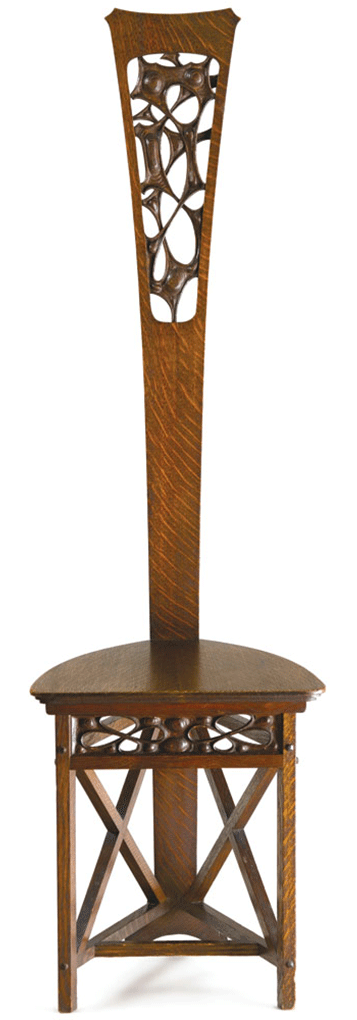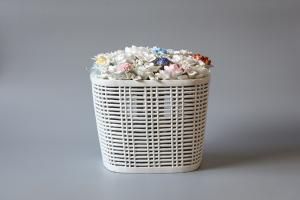THE ARTISTIC FURNITURE OF CHARLES ROHLFS
Carnegie Museum of Art
Heinz Galleries B and C
Artist: Charles Rohlfs
Curator: Joseph Cunningham
Dates: January 30–April 25, 2010
Website: www.cmoa.org
The Artistic Furniture of Charles Rohlfs, featuring more than 40 pieces of furniture and related objects by this protean artist, actor, and furniture-maker will be presented January 30 to April 25, 2010 at Carnegie Museum of Art. The Artistic Furniture of Charles Rohlfs is the first major museum exhibition to bring together this designer’s rich body of work. Charles Rohlfs’ (1853–1936) designs stand alongside those of better-known contemporaries such as Gustav Stickley and Frank Lloyd Wright, but until now have not received the same level of analysis.
Rohlfs combined design motifs in remarkably inventive ways and created furniture like none other, contributing a new chapter to the history of American design. Rohlfs was dedicated to the primacy of individual expression and called his unprecedented creations simply “artistic furniture.” His virtuosic carving and imaginative silhouettes relate to Art Nouveau patterns and a wide range of international design traditions, while his innovations influenced the pared-down oak forms of the Arts and Crafts movement. The Artistic Furniture of Charles Rohlfs draws on research into the Rohlfs family archives and new documentary sources, which reveal the origins of Rohlfs’ designs and the role of his wife, Anna Katharine Green. Additionally, several pieces from the Rohlfs archives are presented for the first time.
“The carved designs of Charles Rohlfs represent some of the most engaging yet long under-researched craftsmanship in American form since 1900,” said Jason T. Busch, The Alan G. and Jane A. Lehman Curator of Decorative Arts at Carnegie Museum of Art. “The American Decorative Art 1900 Foundation, Chipstone Foundation, and the Milwaukee Art Museum exhibition and catalogue provide a compelling argument for the important role Rohlfs played in the trajectory of modern design.”
The exhibition is curated by Joseph Cunningham, Curator of American Decorative Art 1900 Foundation, and organized at Carnegie Museum of Art by Busch. A companion catalogue of the same title was published by Yale University Press in association with American Decorative Art 1900 Foundation.
The Artistic Furniture of Charles Rohlfs has been exhibited at the Milwaukee Art Museum and the Dallas Museum of Art. After its run at Carnegie Museum of Art, the exhibition will travel to the Huntington Library, Art Collections, and Botanical Gardens in Pasadena, California, and the Metropolitan Museum of Art in New York.

The Style of Charles Rohlfs
Rohlfs’ devotion to personal expression has roots in the “art for art’s sake” theories of the late 19th-century Aesthetic Movement. He emphatically denied any connection to particular movements or stylistic influences, although his rich assortment of tables, chairs, chests, and candlesticks, all distinguished by the quality of their hand craftsmanship, reflect such varied sources as Japan, China, the Middle East, and medieval and Renaissance Europe. A modernist in his sensibilities, Rohlfs indirectly endorsed the Arts and Crafts’ tenets of honest workmanship and truth to materials and the Art Nouveau’s obsession with the whiplash line. The Artistic Furniture of Charles Rohlfs will demonstrate Rohlfs’ far-reaching impact on the design of American and European furniture around the turn of the 20th century, particularly the work of Stickley.
About Charles Rohlfs
Rohlfs’ furniture-making was the culmination of a lifetime dedicated to art, design, and theater. Trained in socially progressive artistic ideals at the Cooper Union, Rohlfs went on to design decorative cast-iron stoves for some of the largest industrial foundries in the country, while simultaneously pursuing a career as a stage actor. Rohlfs began designing furniture in 1896 and claimed that his inspiration came from the natural grain of oak and his own creative imagination. He  called his work “artistic furniture” or, simply, “the Rohlfs style” and, in turn, cultivated an enigmatic persona that has persisted to this day. Rohlfs was also among the most skillful American furniture makers of the late 19th century. Although his work features the dark matte oak that would become widely popular as “Mission Style,” Rohlfs was too much of a businessman to embrace the socialist tendencies of William Morris or the utopian visions of his own regional competitors, the Roycroft Shops.
called his work “artistic furniture” or, simply, “the Rohlfs style” and, in turn, cultivated an enigmatic persona that has persisted to this day. Rohlfs was also among the most skillful American furniture makers of the late 19th century. Although his work features the dark matte oak that would become widely popular as “Mission Style,” Rohlfs was too much of a businessman to embrace the socialist tendencies of William Morris or the utopian visions of his own regional competitors, the Roycroft Shops.
During all periods of his career, Rohlfs employed only a few other workers, resulting in his distinctive handprint on each and every piece that carries his name. The exhibition will also speak about Rohlfs’ professional relationship with the author, illustrator, and furniture designer Anna Katharine Green, who later became is wife, providing opportunities for discussing the role of women in modernist design.
Activities
Curator’s Lecture: The Artistic Furniture of Charles Rohlfs
Friday, January 29, 6–6:45 p.m.
CMA Theater; Free
The fascinating life of Charles Rohlfs and the unique furniture he designed in his brief 10-year career are the subjects of this lecture presented by Joseph Cunningham, curator of The Artistic Furniture of Charles Rohlfs. Cunningham is author of the catalogue accompanying the exhibition and Curator of American Decorative Art 1900 Foundation.
Lunch & Learn: Gustav Stickley and Charles Rohlfs
Thursday, March 25, 10:30 a.m.–2 p.m.
$36 members/$45 nonmembers; lunch is included
Call 412.622.3288 to register.
Edward and Kathryn Friedman, local collectors of the furniture of Gustav Stickley, discuss their collecting experience and the relationship between Stickley and rival Charles Rohlfs. After lunch, Jason T. Busch, The Alan G. and Jane A. Lehman Curator of Decorative Arts, offers a tour of The Artistic Furniture of Charles Rohlfs.
Complementary Exhibitions
On view at Carnegie Museum of Art at the same time as The Artistic Furniture of Charles Rohlfs is Gods, Love, and War: Tapestries and Prints from the Collection. This exhibition (which runs until June 13, 2010) features highlights from the museum’s collection of stunning 16th- and 17th-century tapestries and prints. It explores the historical popularity of pictures in textile; the patrons, artists, and studios that created a taste for tapestries; and the thematic intersections between tapestry and print imagery.
On November 21, 2009, the museum reopened the Ailsa Mellon Bruce Galleries of decorative arts and design. The galleries, which have been renovated as part of a multi-phase master plan for the museum, present some 500 examples of American and European decorative arts and design from the mid-18th century through the present day. Many of the objects on display are newly acquired or have never been exhibited to the public.
Support:
The Artistic Furniture of Charles Rohlfs is organized by the Milwaukee Art Museum, the Chipstone Foundation, and American Decorative Art 1900 Foundation. Major support for Carnegie Museum of Art’s presentation is provided by The Henry L. Hillman Fund and the Virginia Kaufman Fund. General support for the exhibition program at Carnegie Museum of Art is provided by The Heinz Endowments, the Pennsylvania Council on the Arts, and Allegheny Regional Asset District.
The Carnegie Museum of Art
Located at 4400 Forbes Avenue in the Oakland section of Pittsburgh, Carnegie Museum of Art was founded by industrialist and philanthropist Andrew Carnegie in 1895. One of the four Carnegie Museums of Pittsburgh, it is nationally and internationally recognized for its distinguished collection of American and European works from the 16th century to the present. The Heinz Architectural Center, part of Carnegie Museum of Art, is dedicated to enhancing understanding of the physical environment through its exhibitions, collections, and public programs. For more information about Carnegie Museum of Art, call 412.622.3131 or visit our Web site at www.cmoa.org.
Conversations:
September 17: The Question of Photography with Linda Benedict-Jones, curator of photography, in the exhibition Digital to Daguerreotype
October 15: Where are the Boundaries? Artists’ Lives and Artists’ Work: Mary Cassatt and Kara Walker with Amanda Zehnder, assistant curator of fine arts, in the permanent collection galleries
November 19 : Tastemakers: Artists Influencing Lifestyle with Raymund Ryan, curator of architecture, in the exhibition Palm Springs Modern: Photographs by Julius Shulman
Visiting the Museum
Carnegie Museum of Art
4400 Forbes Avenue
Pittsburgh, PA 15213-4080
Tel: 412.622.3131
Website: www.cmoa.org
Hours: Tuesday–Saturday: 10 a.m. to 5 p.m.
Thursday: 10 a.m. to 8 p.m.
Sunday: 12 p.m. to 5 p.m.
Monday: Closed*
Closed major holidays
IMAGE CREDITS:
1. Charles Rohlfs, Candelabrum, 1903, ebonzied and gold-rubbed oak, kappa shell, copper, 17 x 16.7 x 7 in. Photo Gavin Ashworth, courtesy of&&160; American Decorative Art 1900 Foundation.
2. Charles Rohlfs in his workshop with George Thiele (far left) and Roland Rohlfs (right), ca. 1901-1902.



